When the winter ends and the warmer spring temperatures come, salamanders and other amphibians will emerge from their overwintering spots, and head to the water to breed. But do salamanders lay eggs?
Most salamander species lay eggs in the water and attach them to submerged vegetation near the water surface. However, some salamanders such as the fire and the alpine salamanders do not lay eggs, and instead, give birth to live young.
Salamander eggs laid in the water look somewhat like frogs eggs and are covered in an outer layer of jelly to protect them from drying out if the water level drops.
Some salamanders, such as the arboreal, red-backed, and slender salamander lay their eggs on land rather than in the water.
Unlike salamander eggs laid in the water, these do not have an outer jelly coat. Rather, they have soft egg sacks and are sometimes covered in slim to protect them from elements.
Most Salamanders Lay Their Eggs in the Water
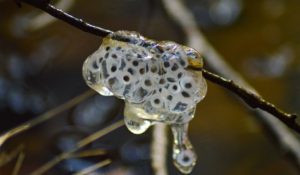
During the first warm rainy night of spring, amphibians such as salamanders and frogs will emerge from brumation (hibernation) and migrate to ponds to reproduce.
This mass amphibian migration is commonly referred to as “the big night”. People will travel to see this event, and very often stop traffic to allow hundreds of salamanders or frogs to cross roads on their way to the breeding ponds.
During this migration, salamanders will sometimes travel up to half a mile, often passing through residential areas to reach areas with deep enough water where they can mate and lay their eggs.
This could be in ponds, roadside ditches, or even deep tire tracks, but most salamanders very strongly prefer to breed in something called “vernal pools“.
Vernal pools are seasonal pools of water. They are formed when depressions on the ground are filled with water from melting snow and falling rain.
Since they are temporal, they do have fish that could eat the salamander eggs before they hatch, which makes them ideal breeding sites.
Once in the water, salamanders will mate, and the female salamander will fertilize her eggs internally. After a few days, she will lay three to four egg masses and attach them to submerged vegetation or on the underside of submerged rocks near the water surface.
Depending on the species, each egg mass can have anywhere from 30 to as many as 250 eggs.
Here are some pictures of salamander eggs laid in the water:


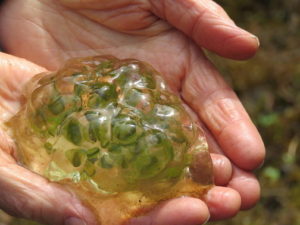
When the eggs are laid, they are embedded in special secretions from a gland in the salamander’s body. These secretions combine with water to create a jelly-like coating around the entire egg mass.
The jelly is usually clear or cloudy white but can be slightly different colors depending on the salamander species. It can be brown, cream-colored, or even have a bright green glow from algae.
The jelly protects the eggs from drying out if the water level in the pool drops. It also protects them from predators such as frogs or newts.
Some Salamanders Lay Their Eggs on Land
Some salamanders, such as the arboreal and the red-backed salamander lay their eggs on land, rather than in the water.
This could be in moist soil, in damp rotting logs, underneath leaf litter, or on the underside of rocks. Arboreal salamanders are even known to lay eggs high up in the forest canopy.
Unlike salamander eggs laid in the water, salamander eggs laid on land do not have a layer of jelly surrounding the egg mass.
Instead, the individual eggs have soft egg sacks to protect them from the elements and are sometimes covered in slime.
Here are some pictures of salamander eggs laid on land:

 The female salamanders usually remain with their eggs to protect them from predators, and may even coil up around them to prevent them from drying out.
The female salamanders usually remain with their eggs to protect them from predators, and may even coil up around them to prevent them from drying out.
Some Salamanders Lay Aquatic Eggs in Dried up Pools
Unlike most salamanders that breed in water in the spring, some salamanders, such as the marbled salamander will breed in the fall. Marbled salamanders also have unusual reproductive behavior; instead of laying eggs in the water, they lay “aquatic” eggs on land.
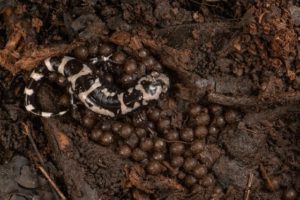
These eggs are usually laid in dried-up pools, usually under logs or leaf litter. The female will remain with her eggs to keep them moist until the rain comes and fills the pool up with water.
Once submerged, tiny larvae will hatch from the eggs and live an aquatic life until they metamorphose into terrestrial juvenile salamanders.
Where Different Salamander Species Will Lay Their Eggs
Here is a table showing where different salamander species will lay their eggs:
| Species of Salamander | Where They Lay Their Eggs |
| Tiger salamander | In water |
| Spotted salamander | In water |
| Marbled salamander | In dried up pools, that will fill with water |
| Blue-spotted salamander | In water |
| Red salamander | In water |
| Long-toed salamander | In water |
| Two-lined salamander | In water |
| Jefferson salamander | In water |
| Red-backed salamander | On land |
| Slender salamanders | On land |
| Arboreal salamander | On land |
| Slimy salamander | On land |
| Mud salamander | On land near water |
| Dusky salamanders | On land near water |
| Spring salamander | In water |
| Four-toed Salamander | On land near water |
| Long-tailed salamander | In water |
| Green salamander | On land |
| Ensatina Salamanders | On land |
| Cave salamander | In water found in caves |
| Small-mouthed salamander | In water |
| Streamside salamander | In water |
How Long Does It Take Salamander Eggs to Hatch?
Most salamander eggs will hatch about two to three weeks after they are laid. However, this will vary widely depending on the species and the environmental conditions. Some eggs may hatch after only a week, while others may take over two months before they hatch.
After hatching baby salamanders from aquatic eggs (larvae) will live a fully aquatic life, just like frog tadpoles, until they transform into adult salamanders and leave to water.
Salamanders that hatch from terrestrial eggs, on the other hand, typically do not have a larval stage. They are well-developed and look just like miniature versions of the adult salamanders when they hatch.
What Baby Salamanders Look Like When They Hatch
The newly hatched larvae of most salamander species live entirely in the water, just like frog tadpoles. They have a flat tail fin that runs down the length of their body, and external feathery gills which they use to breathe in the water.
Here is a picture of newly hatched salamander larvae:
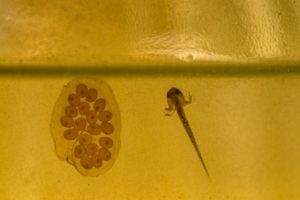
Here is a picture of 2-week salamander larvae:
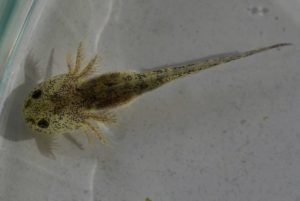
These larvae will stay in the water munching on small worms and other small aquatic invertebrates to grow and get ready to transform into adults through a process known as metamorphosis.
During metamorphosis;
- Their gills will shorten and eventually be absorbed into the head
- They may develop lungs for breathing air (some adult salamanders do not have lungs, they breathe entirely through their skin)
- They develop strong legs for walking long land
- Their flat tail will shorten and become more rounded
Once this process is fully complete, the larvae will transform into adult salamanders that most people are more familiar with.
What Baby Salamanders From Terrestrial Eggs Look Like
As mentioned earlier, salamanders that hatch from terrestrial eggs do not have a larval stage.
These salamanders will look just like the adult salamanders, only smaller. It’s kind of similar to how baby lizards look just like miniature versions of their parents.
Here is a picture of a baby arboreal salamander:
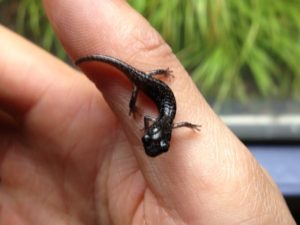
Here is a picture of a baby slender salamander:
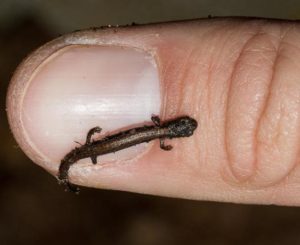
Some Salamanders Give Birth to Live Young
While most salamanders lay eggs, some salamanders, such as the fire and the alpine salamanders mate on land and give birth to live young.
In these salamanders, the embryos develop inside their eggs inside the mother salamander’s body and hatch just before birth. This is known as “ovoviviparity“.
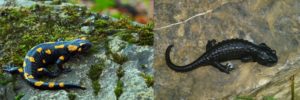
In most fire salamander subspecies, mating usually takes place in the late summer or early fall, and the larvae are born the following spring.
To give birth, the female will crawl backward and immerse her cloaca in shallow, usually slow-moving water. She then releases about 15 to 70 well-developed aquatic larvae, but this number can vary depending on the subspecies.
However, Salamandra s. bernardezi, a subspecies of fire salamander that can be found from Austria to Spain, is unique because it gives birth to completely metamorphosed young salamanders. These newborns will live a terrestrial life from the moment of their birth.
Alpine salamanders also give birth to fully-developed juveniles. In these salamanders, one embryo develops from the first egg in each uterus.
The embryo then feeds on the yolk of the other eggs, which dissolve into a large mass of nutrients.
Pregnancy can last 2-3 years and the female salamander will give birth in a protected moist environment to keep the newborns safe. The newborn salamanders are fully developed and will live a terrestrial life from the day of their birth.
Aquatic Salamanders Have Unique Breeding Behavior
Unlike most salamanders that fertilize their eggs internally, some aquatic salamanders such as the hellbender fertilize their eggs externally. Hellbenders will typically mate in the fall.
Before mating, the male hellbender will excavate a saucer-shaped nest under a rock or log, and wait for the female to arrive. When the female arrives, the male will guide her into his nest to lay her eggs.
As the female begins to deposit eggs, the male will simultaneously release sperm to fertilize her clutch. The female will lay between 100-300 eggs that are attached to each other and have a stringy, beaded appearance.
After egg laying is complete, the male drives off the female and defends the nest from predators for the next 45-75 days until the eggs hatch into tiny larvae.
Mudpuppies
Mudpuppies also breed in the fall. However, unlike hellbenders, mudpuppies fertilize their eggs internally rather than externally.
Before mating, females will dig a hollowed-out depression under a large flat rock or a log in shallow water. During mating, the male will drop a spermatophore (a capsule that holds sperm), and the female picks up with her cloaca to fertilize her eggs internally.
When ready to lay her eggs, the female will turn upside down and attach the eggs to the bottom of the rock (or log) over her nest. One female can lay anywhere from 30 to as many as 200 eggs.
She will then stay with her eggs to defend them from predators until they hatch, which typically takes 1 to 2 months.
Axolotls
Axolotls mate in spring and breed in a very similar way to other mole salamanders, such as the tiger and the spotted salamander.
The male will release a spermatophore, and the female picks it up with her cloaca and fertilizes her eggs internally. She then lays from 100 to 300 eggs and attaches them to submerged sticks, grass, and other vegetation.
Sirens
Sirens mate in spring and will lay anywhere from 12 to 300 eggs at the bottom of the water, usually among plant roots and surrounded by vegetation.
Since very little research has been done into the reproduction of these salamanders, not much is known about their mating behavior.
However, it is assumed to be violent because bite marks have been found, mostly on females during the mating season.
This assumption has been challenged because biting has also been observed out of the mating season.
Related Questions:
Question: Do Salamanders Eat Their Own Eggs?
Answer: Most salamander species will eat many of their own and other salamanders eggs. Hellbenders sometimes eat more than half of their own eggs.
Question: What Animals Eat Salamander Eggs?
Answer: The main predators of salamander eggs are birds, frogs, newts, large salamander larvae, and adult salamanders. Eggs laid in water with fish will also face predation by fish.
Final Thoughts
The majority of salamanders lay eggs, but not all do. The salamanders that lay eggs typically lay them in the water, and attach them to submerged vegetation or rocks just below the water surface.
These eggs are covered in an outer layer of jelly surrounding the egg mass. The jelly functions to shield the eggs from the elements, and to prevent them from drying out if the water level drops.
Some salamanders such as the dusky and red-backed salamander lay eggs in moist places on land rather than in the water. Unlike salamander eggs laid in water, these do not have an outer jelly coat.
Instead, each individual egg has a soft egg sack to protect the embryos as they develop inside the eggs.
Salamanders such as the fire and the alpine salamander do not lay eggs, instead, they give birth to live young.


